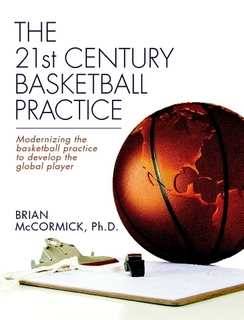I know that many of you are already thinking what does this book have to do with education? Here he goes with one of those off the wall posts that he does every so often.
I love education. I love coaching. I have been coaching basketball for 12 years and I get so excited every single year. Through my many years of coaching and learning to get better as a leader and coach I have found a deep respect for Brian McCormick.
His latest book The 21st Century Basketball Practice: Modernizing the basketball practice to develop the global player. is nothing short of amazing.
What I discovered while reading this book is how much teaching/education/parenting/learning/coaching are really all the same. I read the Kindle version and 61 highlights later I could interchangeably use the ideas from this book on the basketball court AND the classroom.
The overall vibe of the book is to help coaches learn to connect with the players, allow them to create their own learning, and provide guidance as needed. The way this happens is to provide voice and choice, quality feedback, and preparing the players/students for the real world situations. Sound similar to a classroom? Yes, it does.
I won’t share all my highlights as you can connect with me on Amazon Kindle, but here are a couple that I think are very important to share.
1. Players make mistakes for three reasons. They don’t understand. They aren’t good enough yet to do what is asked of them or at least not good enough yet to execute consistently. They don’t care.
Often in practice we focus on helping players understand and develop their skills. Sports are nice in that players not caring is not a huge issue(it does exist however) compared to the classroom. Often times in the classroom we blame students not caring instead of looking at the realization that perhaps they don’t understand and we must change our teaching or maybe they simply are not able to process what we expect. In the end I don’t think any of these options require punishment, but taking time to improve and explaining the “why” of what we do.
2. [bctt tweet=”Use mistakes as teaching moments”]Use mistakes as teaching moments. Brian states several times not to intervene until the mistake is made three times. Give players time to correct the error. I love this and this is something I have worked to not stop every single play. In the classroom, we rarely use mistakes as teaching moments. We post the grade and move on. Rarely do we give time for students to make several mistakes and try to learn before we intervene. I am not sure how to pull this off in the classroom, but it is important to at least consider.
3. [bctt tweet=”The only perfect technique is one that achieves the goal”]
I love this! It might be my favorite. We are all different and do things differently. If we have a system or technique that works, why would we try to fix it? Whether on the court or classroom we sometimes have to accept that others do things different from us and that is okay as long as they can get the job done.
I could go on and on, but you get a small feel for the book. I will blog more based on what I learned from this book, but if you like learning, coaching, and teaching then this book is important to read. Even if you are not a basketball coach there is something for anyone who works with students and/or players in the classroom, court, or field.
His ideas on practice goals, feedback, mistakes, reflection, and questioning why we do what we do are essential for all of us to ponder and find answers. We may not like the answers we provide, but then that is the opportunity to try and make change for the better.
At the end of the day we only have so much time with our players and students so why not work hard to make the best use of the time so you feel satisfied that you did all you could do to prepare them for the global world they are living in?
As a good friend, colleague, and teacher in my school told me when I was talking to him about this book. “I coach Spanish and I teacher basketball.”
I would also recomend all of his other books

Leave a Reply